

10/17/20: Johns Hopkins Researchers Identify Immune System Pathway That May Stop COVID-19. Colorized scanning electron micrograph of a cell (purple) heavily infected with SARS-CoV-2 virus particles (yellow).
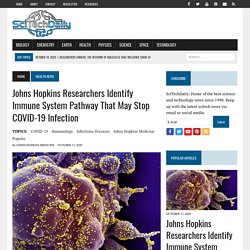
A recent study by Johns Hopkins Medicine shows that blocking a specific protein in a biological pathway may prevent SARS-CoV-2 infection and keep the virus from misdirecting the immune system against healthy cells and organs. Credit: National Institute of Allergy and Infectious Diseases, National Institutes of Health. Mini organs reveal how the coronavirus ravages the body.
Researchers are growing miniature organs in the laboratory to study how the new coronavirus ravages the body.
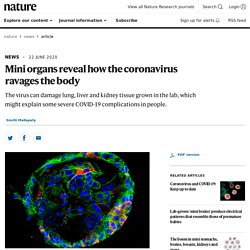
Studies in these organoids are revealing the virus’s versatility at invading organs, from the lungs to the liver, kidneys and gut. Researchers are also experimenting with drugs in these mini tissues to see whether such therapies might be candidates to treat people. Mounting clues suggest coronavirus might trigger diabetes. In mid-April, Finn Gnadt, an 18-year-old student from Kiel, Germany, learnt that he had been infected with the SARS-CoV-2 coronavirus despite feeling well.

Gnadt’s parents had fallen ill after a river cruise in Austria, so his family was tested for virus antibodies, which are produced in response to infection. Gnadt thought he had endured the infection unscathed, but days later, he started to feel worn out and exceedingly thirsty. 5/22/20: coronavirus 'does not spread easily' from touching surfaces or objects, CDC says. Editor's Note: The Centers for Disease Control and Prevention (CDC) released a statement on Friday (May 22) saying this updated wording was done in an attempt to clarify spread beyond person-to-person.

"This change was intended to make it easier to read, and was not a result of any new science," the agency wrote in the statement. "After media reports appeared that suggested a change in CDC’s view on transmissibility, it became clear that these edits were confusing. Therefore, we have once again edited the page to provide clarity. " Why children avoid worst coronavirus complications might lie in their arteries. Since the coronavirus outbreak began, scientists have been trying to work out why children are much less likely than adults to experience severe complications from the infection.

Now research suggests that the answer might lie in children’s healthy blood vessels. Children make up only a small proportion of those infected by SARS-CoV-2, the virus that causes COVID-19. A large survey by the US Centers for Disease Control and Prevention in Atlanta, Georgia, found that children aged 17 and under, who make up 22% of the US population, account for fewer than 2% of confirmed COVID-19 infections across the United States. And, of 2,572 children included in the survey, only 5.7% went to hospital and only three died. Several theories have been proposed to explain why children aren’t getting so ill. Ibuprofen tested as a coronavirus treatment. Image copyright Getty Images Scientists are running a trial to see if ibuprofen can help hospital patients who are sick with coronavirus.

The team from London's Guy's and St Thomas' hospital and King's College believe the drug, which is an anti-inflammatory as well as a painkiller, could treat breathing difficulties. They hope the low-cost treatment can keep patients off ventilators. In the trial, called Liberate, half of the patients will receive ibuprofen in addition to usual care. The trial will use a special formulation of ibuprofen rather than the regular tablets that people might usually buy.
Studies in animals suggest it might treat acute respiratory distress syndrome - one of the complications of severe coronavirus. Prof Mitul Mehta, one of the team at King's College London, said: "We need to do a trial to show that the evidence actually matches what we expect to happen. " Indirect Virus Transmission in Clusters of COVID-19 (Wenzhou, China, 2020)
Author affiliations: Wenzhou Sixth People’s Hospital, Wenzhou Central Hospital Medical Group, Wenzhou, China (J.
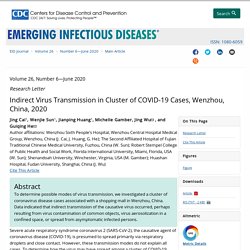
Cai, J. Huang, G. He); The Second Affiliated Hospital of Fujian Traditional Chinese Medical University, Fuzhou, China (W. The Latest in Coronavirus Science. 1 in 5 w/COVID-19 are co-infected with other viruses/ bacteria. Observational Study of Hydroxychloroquine in Hospitalized Patients with Covid-19. Setting We conducted this study at New York–Presbyterian Hospital (NYP)–Columbia University Irving Medical Center (CUIMC), a quaternary, acute care hospital in northern Manhattan.

3/25/20: Young, middle-aged people, barely sick with COVID-19, dying from strokes. Oxley gasped when he got to the patient’s age and covid-19 status: 44, positive.
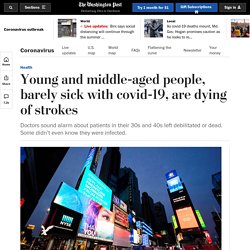
The man was among several recent stroke patients in their 30s to 40s who were all infected with the coronavirus. The median age for that type of severe stroke is 74. As Oxley, an interventional neurologist, began the procedure to remove the clot, he observed something he had never seen before. On the monitors, the brain typically shows up as a tangle of black squiggles — “like a can of spaghetti,” he said — that provide a map of blood vessels. A clot shows up as a blank spot. “This is crazy,” he remembers telling his boss. Stroke surge. 4/17/20: Stanford sudy suggests covid-19 is far more widespread than previously thought. A new study in California has found the number of people infected with coronavirus may be tens of times higher than previously thought.
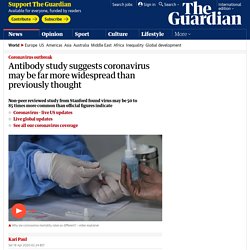
The study from Stanford University, which was released Friday and has yet to be peer reviewed, tested samples from 3,330 people in Santa Clara county and found the virus was 50 to 85 times more common than official figures indicated. To ease the sprawling lockdowns currently in place to stop the spread of Covid-19, health officials must first determine how many people have been infected. Large studies of the prevalence of the virus within a region could play a key role, researchers say. “This has implications for learning how far we are in the course of the epidemic,” said Eran Bendavid, the associate professor of medicine at Stanford University who led the study.
“It has implications for epidemic models that are being used to design policies and estimate what it means for our healthcare system.” Other large-scale sample studies are currently underway. 4/21/20: Study suggests CoV2 has mutated into at least 30 different strains. A new study in China has found that the novel coronavirus has mutated into at least 30 different variations.The results showed that medical officials have vastly underestimated the overall ability of the virus to mutate, in findings that different strains have affected different parts of the world, leading to potential difficulties in finding an overall cure.
The study was carried out by Professor Li Lanjuan and colleagues from Zhejiang University in Hangzhou, China and published in a non-peer reviewed paper released on website medRxiv.org on Sunday.Li's team analyzed the strains from 11 randomly chosen coronavirus patients from Hangzhou, where there have been 1,264 reported cases, and then tested how efficiently they could infect and kill cells.More than 30 different mutations were detected, of which 19 were previously undiscovered. 4/10/20: What Iceland learned from testing 10% of its population for Covid-19. Dr. Thorolfur Gudnason, Iceland's chief epidemiologist explains how the country is aiming to find out more about how the COVID-19 disease spreads.
USA TODAY Iceland has achieved something no other country has: tested 10% of its population for coronavirus, a figure far higher than anywhere else in the world. No country or scientist or doctor has all the answers about the pandemic that has swept the globe, infecting more than 1.6 million people and killing at least 95,000. Morbidity and Mortality Weekly Report (MMWR)